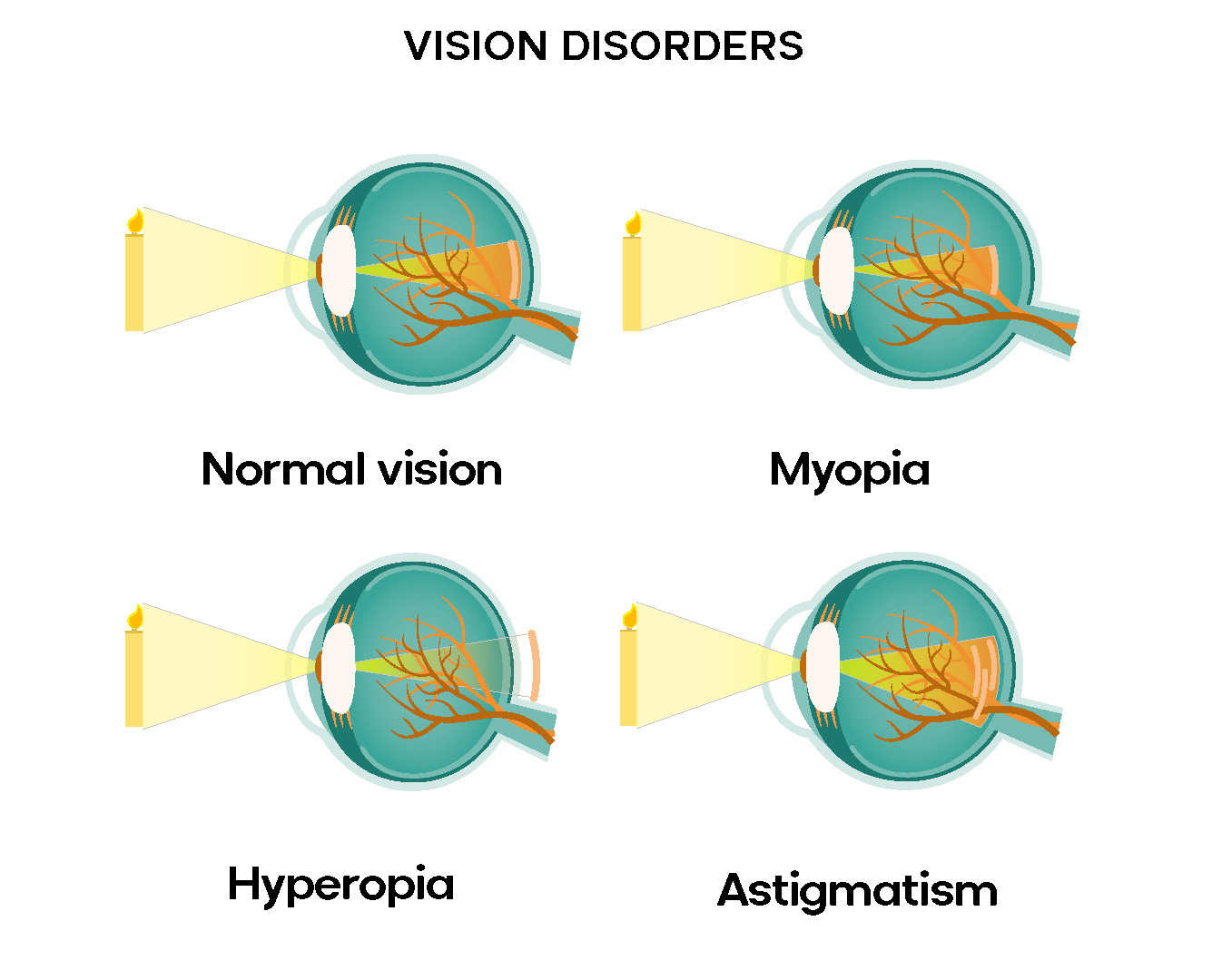It can start with reports of a slight blurring of words on a page, or difficulty reading a menu in a dimly lit room. Maybe an account of the eyes feeling dry or gritty. Patients may say that driving at night can present challenges in the form of “halos” around bright lights. Vision changes, which can begin as early as age 411 and tend to progress over time, are a normal part of getting older. Later, usually after the age of 60, some of these symptoms may be attributable to cataracts.
“Just like every part of the body, with time, the eye will undergo natural aging changes," says Giovanna Olivares, O.D, F.A.A.O., director of a vision research and development team at Johnson & Johnson. “And with those changes comes a gradual loss of function.”
Today, there are more vision changes to be addressed than ever before. Globally, the older population is dramatically increasing: The number of people over 60—around 1 billion right now—is projected to climb to 1.4 billion by 2030, and 2.1 billion by 2050.
To meet these patients with solutions, it’s essential to understand the structural and biological changes that happen within the eye, as well as what new advances in technology can provide.
Understanding astigmatism
In a normal eye, when the cornea—the front layer of the eye that light hits first—is perfectly round, light is focused uniformly on the retina in the back of the eye, resulting in perfect vision. If light rays focus singularly in front of the retina, we say that person has myopia,2 or nearsightedness, which can make it hard to see distant objects. Conversely, if light rays focus singularly behind the retina, this causes hyperopia,3 or farsightedness, which makes it tricky to see things up close.
When someone has corneal astigmatism,4 a common condition that is defined by an imperfection in the curvature of the eye's cornea or lens, the shape of the cornea is more like an American football instead of round like a basketball. When a light ray hits the long side of the football shape, it will bend in a very different way than if it hits the short side of the football. This causes two distinct foci, which results in blurring. “In order for me to correct an astigmatic eye, I need to use vision-correcting lenses to bring those two points into one focus, and then to bring them onto the retina,” says Olivares.
While corneal astigmatism is the predominant form in younger individuals, lenticular astigmatism5—another subset of the condition—becomes more prevalent with age. This occurs when vision changes stem from the lens inside the eye rather than the cornea. At birth, the crystalline lens inside the eye, which focuses light on the retina, is perfectly clear. With age, however, proteins and metabolites accumulate in the lens,6 causing it to become cloudy and develop cataracts. This process can alter the shape of the natural lens and lead to lenticular astigmatism.
Presbyopia: when close-up vision becomes challenging
Aging can also lead to presbyopia,7 the gradual loss in the eye’s ability to focus on close objects. This happens when proteins inside the eye’s natural lens denature, changing not only the lens’s shape but also its flexibility.
The rigidity or flexibility matters because the eye’s crystalline lens focuses by changing its shape. It becomes fatter or flatter, depending on the distance of the object it is viewing. The more rigid a lens gets, the less capable it is of quickly and automatically focusing on objects at different distances. As eyes age, they’re not as flexible, so they lose the ability to change shape readily, which can lead to difficulty focusing on nearby objects.8
Dry eyes and the aging process
Another symptom of aging is dry eye syndrome,9 which can cause irritation and blurred vision. As people grow older, the quality and quantity of the tear film reduces, leading to red, itchy and burning eyes. The problem is exacerbated by increased screen use,10 as people blink less while using digital devices,11 destabilizing the tear film that impacts both comfort and vision. Indeed, adults are now spending more than 13 hours a day on digital devices, a 35% increase12 over the past six years.
This is an issue Christi Closson, O.D., F.A.A.O., Associate Director of Professional Education and Vision at Johnson & Johnson, sees in her patients as they get older. Over her 27 years of work in the field, she has also seen technology for dry eyes evolve significantly.

How pupil size affects aging vision
As people get older, their pupils get smaller.13 This is because of a variety of reasons, such as structural iris damage like stiffness and muscle degeneration, sympathetic and parasympathetic deficits as well as deficiency in central inhibition, all of which can compromise vision. A smaller pupil limits the amount of light that enters into the eye, therefore making it more difficult to see at night or in a dimly lit room. Of interest, nearsighted eyes, which have a hard time seeing items at a distance, have bigger pupils than farsighted eyes.14
Factors such as deviations in pupil size—or, often, early cataract formation—can cause difficulty driving at night, as eyes struggle to adjust between bright headlights and dark roads. Often, patients refer to a “halo” that they see around headlights or lights at night that can obscure vision.
Johnson & Johnson developed ACUVUE® PUPIL OPTIMIZED Design Multifocal specifically for presbyopic patients to help them stay in contact lenses, even as it becomes more difficult with age to focus on nearby objects. It is a unique optical design system that takes into account the natural pupil variation that occurs both across the refractive error range and with patient age.
New contact lens options for aging eyes
As research behind aging eyes deepens, there is an opportunity to build new solutions. And Dr. Olivares and her team are at the forefront of this work.
“What we aim to deliver in a contact lens is the focusing ability to see everything people want to see—whether it’s from a far distance, intermediate, or near,” she says. “It sounds like it's a simple task, but it's not.”
The latest product Johnson & Johnson researchers developed is the ACUVUE® OASYS MAX 1-Day Multifocal for Astigmatism Contact Lens. It takes the changes associated with the mature eye into account, ensuring the lenses are designed to address multiple vision challenges, including:
· Variations in pupil size because of age and refractive error
· Myopia or hyperopia
· People who may be experiencing different severity of astigmatism based on their aging eyes
· Contact lens–related dryness
· Class 1 UV protection#^
· Highest level of blue-violet light filtering+‡
“Our optical engineers did an incredible job of creating an optical design on the patient anatomy and their visual needs,” Olivares says. “One hundred percent of our parameters are optimized for pupil size variation because of age and optical power.15 It’s a transformative innovation that combines four best-in-class technologies to serve a broad presbyopic patient population, and will be the first and only daily disposable toric multifocal contact lens in the market when it launches.”
This new lens combines BLINK STABILIZED® Design for astigmatism correction with PUPIL OPTIMIZED Design for multifocal correction. The lens also features UV protection#^, TearStable™ Technology to lock in moisture for better comfort and tear stability and the OptiBlue™ Light Filter+‡ to provide blue-violet light filtration.
In terms of meeting multifocal needs, “progressive glasses with no line are great, and were revolutionary when they came out,” Closson says. But it’s not the same experience as wearing a contact lens. “When you have multifocal lenses on, it’s an immersive experience; it’s mimicking your 20-year-old eyes. The brain perceives the lens as being the eye itself, and you have clear distance, clear intermediate and clear near vision.”
Closson has found the ease of a daily disposable lens has helped patients new to contact lenses clear the mental hurdle of trying them out. She is inspired by seeing new vision care products roll out that can serve new patient populations.
“We have such great technology, research and development on our side right now. It's a great time to be working in vision care,” Closson says. “You don't want to have to think about your vision and have it be a difficult part of your daily life. We should all be able to say, ‘I have reliable vision, and I can see clearly everywhere I look.’”
References
1 “Adult Vision: 41 to 60 Years of Age,” American Optometry Association https://www.aoa.org/healthy-eyes/eye-health-for-life/adult-vision-41-to-60-years-of-age?sso=y
2 David Turbert, “Nearsightedness: What Is Myopia?” American Academy of Ophthalmology, November 7, 2024 https://www.aao.org/eye-health/diseases/myopia-nearsightedness#causes
3 Daniel Porter, “Farsightedness: What Is Hyperopia?” American Academy of Ophthalmology, October 24, 2024 https://www.aao.org/eye-health/diseases/hyperopia-farsightedness
4 “Astigmatism,” Mayo Clinic https://www.mayoclinic.org/diseases-conditions/astigmatism/symptoms-causes/syc-20353835
5 “Astigmatism,” Mayo Clinic https://www.mayoclinic.org/diseases-conditions/astigmatism/symptoms-causes/syc-20353835
6 Skorin L Jr, Norberg S. The aging crystalline lens: a review of cataracts. Consultant, 2019;59(1):13-17,19. https://www.consultant360.com/article/consultant360/ophthalmology/aging-crystalline-lens-review-cataracts
7 Kierstan Boyd, “What is Presbyopia?” American Academy of Ophthalmology, October 24, 2024 https://www.aao.org/eye-health/diseases/what-is-presbyopia
8 “Presbyopia” Mayo Clinic https://www.mayoclinic.org/diseases-conditions/presbyopia/symptoms-causes/syc-20363328#
9 Anushree Sharma, Holly B Hindman, “Aging: A Predisposition to Dry Eyes,” Journal of Ophthalmology, August 14 2014 https://pmc.ncbi.nlm.nih.gov/articles/PMC4150485/
10 Zaina Al-Mohtaseb, Scott Schachter, Bridgitte Shen Lee, Jaclyn Garlich, William Trattler, “The Relationship Between Dry Eye Disease and Digital Screen Use,” Clinical Ophthalmology, September 10 2021 https://pmc.ncbi.nlm.nih.gov/articles/PMC8439964/
11 “Computer vision syndrome,” American Optometric Association https://www.aoa.org/healthy-eyes/eye-and-vision-conditions/computer-vision-syndrome?sso=y
12 Eyesafe. COVID-19: Screen Time spikes to over 13 hours per day according to Eyesafe Nielsen estimates. March 28, 2020. https://eyesafe.com/covid-19-screen-time-spike-to-over-13-hours-per-day/
13 Rafael Lazar, Josefine Degen, Ann-Sophie Fiechter, Aurora Monticelli, Manuel Spitschan “Regulation of pupil size in natural vision across the human lifespan,” The Royal Society, 19 June 2024 https://doi.org/10.1098/rsos.191613
14 Guillon M, Dumbleton K, Theodoratos P, Gobbe M, Wooley CB, Moody K. The Effects of Age, Refractive Status, and Luminance on Pupil Size. Optom Vis Sci. 2016 Sep;93(9):1093-100. doi: 10.1097/OPX.0000000000000893. PMID: 27232893; PMCID: PMC5006796.
15 JJV Data on File: Technical Description of ACUVUE® OASYS MAX 1-Day MULTIFOCAL for ASTIGMATISM
# Helps protect against transmission of harmful UV radiation to the cornea and into the eye. ^ WARNING: UV-absorbing contact lenses are NOT substitutes for protective UV-absorbing eyewear such as UV-absorbing goggles or sunglasses because they do not completely cover the eye and surrounding area. You should continue to use UV-absorbing eyewear as directed. NOTE: Long-term exposure to UV radiation is one of the risk factors associated with cataracts. Exposure is based on a number of factors such as environmental conditions (altitude, geography, cloud cover) and personal factors (extent and nature of outdoor activities). UV-blocking contact lenses help provide protection against harmful UV radiation. However, clinical studies have not been done to demonstrate that wearing UV-blocking contact lenses reduces the risk of developing cataracts or other eye disorders. Consult your eye care practitioner for more information.
+ Filtering of HEV light by contact lenses has not been demonstrated to confer any health benefit to the user, including but not limited to retinal protection, protection from cataract progression, reduced eye strain, improved contrast, improved acuity, reduced glare, improved low light vision, or improved circadian rhythm/sleep cycle. The Eye Care Professional should be consulted for more information.
‡ Versus publicly available information for standard daily use contact lenses as of December 2023.
Important Information for Contact Lens Wearers: ACUVUE Contact Lenses are available by prescription only for vision correction. An eye care professional will determine whether contact lenses are right for you. Although rare, serious eye problems can develop while wearing contact lenses. To help avoid these problems, follow the wear and replacement schedule and the lens care instructions provided by your eye doctor. Do not wear contact lenses if you have an eye infection, or experience eye discomfort, excessive tearing, vision changes, redness or other eye problems. If one of these conditions occurs, remove the lens and contact your eye doctor immediately. For more information on proper wear, care and safety, talk to your eye care professional, call 1-800-843-2020, or download the Patient Instruction Guides.
2025PP07585

